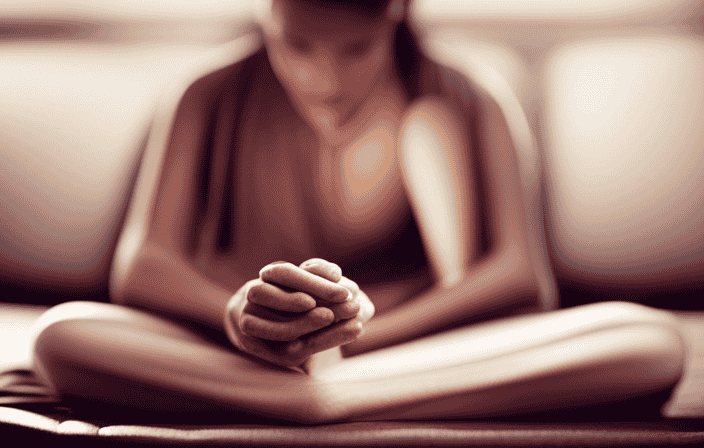Imagine a world where you can find tranquility in the midst of chaos, concentration amid distractions, and serenity amidst stress. This world is not just a far-off dream, but a tangible reality that can be attained through the practice of mindfulness.
By simply noticing our breath, surroundings, feelings, and thoughts, we can bring a sense of tranquility and contentment to our everyday lives.
In this article, we will explore the power of mindfulness and how it can enhance our focus, reduce stress, and lead to a more fulfilling existence.
Welcome to the journey of bringing mindfulness to everyday life.
Key Takeaways
- Mindfulness enhances the present moment experience and increases engagement and focus.
- Engaging in routine tasks mindfully can reduce stress and distractions.
- Cultivating mindfulness in daily activities allows for a deeper connection with oneself and promotes overall well-being.
- Bringing mindfulness into everyday life can enhance focus, reduce stress, and cultivate a sense of peace and relaxation.
What is mindfulness?
I notice that mindfulness is about being present and aware of my breath, surroundings, feelings, and thoughts. This helps to reduce stress and bring a sense of peace and calmness to my everyday life.
It’s amazing how simply paying attention to the small things, like the sound of birds chirping or the feeling of my feet on the ground, can instantly bring me a sense of tranquility.
Mindfulness allows me to fully engage with the present moment, rather than getting caught up in worries about the past or future. It’s a practice that brings clarity and focus to my mind, helping me to better navigate the challenges of daily life.
Through mindfulness, I am able to cultivate a deeper connection with myself and the world around me. This ultimately enhances my overall well-being.
Benefits in daily life
Incorporating mindfulness into daily activities promotes a sense of calm and overall well-being. When I bring mindfulness to my everyday life, I am able to focus more on the present moment and let go of stress and distractions.
By taking a few moments to pause and notice my breath, surroundings, and sensations, I am able to cultivate a sense of peace and clarity. Mindfulness allows me to fully engage in routine tasks, such as washing the dishes or walking in nature, with a heightened sense of awareness and appreciation. It reminds me to slow down and savor the small moments in life, like the warmth of sunlight on my skin or the taste of a delicious meal.
By incorporating mindfulness into my daily life, I am able to navigate challenges with greater resilience and kindness towards myself and others.
Mindfulness in education
Implementing mindfulness in education enhances students’ focus and emotional well-being. By incorporating mindfulness practices into the school curriculum, students are given the opportunity to develop important life skills that go beyond academic achievement.
Mindfulness helps students become more present in the classroom, allowing them to fully engage in their learning and overcome distractions. It also promotes emotional regulation, helping students manage stress and develop resilience.
Through mindfulness, students learn to cultivate a sense of compassion and empathy towards themselves and others, creating a more positive and supportive learning environment. By teaching mindfulness in schools, we are equipping students with valuable tools that they can carry with them throughout their lives, helping them navigate challenges with clarity and compassion.
Mindfulness at work
Practicing mindfulness at work allows me to stay present and focused, resulting in a more calm and productive work environment. When I am mindful, I am able to fully engage in my tasks and give them my undivided attention. This not only improves the quality of my work but also reduces stress and overwhelm.
Here are three ways mindfulness enhances my work experience:
-
Taking short breaks for mindfulness exercises helps me recharge and refocus. It allows me to step away from the busyness and bring my attention back to the present moment.
-
Addressing distractions with mindfulness helps me maintain a sense of calm and clarity. Instead of getting caught up in the noise and interruptions, I can choose to respond with intention and focus.
-
Actively practicing mindfulness during meetings and interactions with colleagues allows me to truly listen and connect. This strengthens relationships and fosters a collaborative work environment.
By incorporating mindfulness into my workday, I am able to navigate challenges with greater ease and find joy in the present moment.
Mindfulness with family
When I am mindful with my family, I am able to fully engage in meaningful conversations and create stronger connections. Being present and actively listening to my loved ones allows me to understand their needs, emotions, and experiences on a deeper level. It helps me to appreciate the little moments and create a nurturing and supportive environment for everyone. Mindfulness also enables me to respond to conflicts and challenges with compassion and empathy, rather than reacting impulsively. By practicing mindfulness with my family, I am fostering a sense of togetherness and building a foundation of trust and understanding. It is truly a gift to be fully present and connected with the ones I love.
| Mindfulness with Family | Benefits |
|---|---|
| Active listening | Enhances understanding and empathy |
| Creating a nurturing environment | Fosters emotional well-being |
| Responding with compassion | Strengthens relationships |
| Appreciating the little moments | Cultivates gratitude |
| Building trust and understanding | Creates a sense of togetherness |
Mindfulness apps and resources
Using mindfulness apps and resources allows me to easily incorporate mindfulness into my daily routine and access a wide range of guided meditations and exercises. These apps provide convenience and accessibility, making it effortless for me to practice mindfulness wherever and whenever I want.
Here are four ways mindfulness apps and resources have enhanced my mindfulness journey:
-
Guided Meditations: These apps offer a variety of guided meditations that help me focus on my breath, body sensations, and thoughts. The soothing voices and calming music guide me into a state of relaxation and presence.
-
Mindfulness Exercises: The apps also provide exercises that I can integrate into my daily activities, such as mindful eating or walking. These exercises help me stay present and fully engage with the task at hand.
-
Progress Tracking: Many apps have features that allow me to track my progress and set reminders for regular mindfulness practice. This motivates me to stay consistent and observe my personal growth over time.
-
Community Support: Some apps provide a community platform where I can connect with like-minded individuals, share experiences, and seek guidance. This sense of community support encourages me to continue my mindfulness journey and learn from others.
Overall, mindfulness apps and resources have been invaluable tools in enhancing my focus, reducing stress, and cultivating a greater sense of peace and well-being in my everyday life.
Incorporating mindfulness in routine tasks
Incorporating mindfulness into my routine tasks allows me to find calmness and presence in the midst of my daily activities. Whether it’s washing dishes, folding laundry, or even brushing my teeth, I have discovered that these seemingly mundane tasks can be transformed into moments of peace and self-reflection. By bringing my awareness to the present moment, I am able to fully engage with each action, observing the sensations, thoughts, and emotions that arise without judgment. This simple practice has brought a sense of clarity and focus to my daily life, reducing the distractions and anxieties that often accompany my tasks.
To emphasize the benefits of incorporating mindfulness into routine tasks, consider the following table:
| Task | Mindful Approach |
|---|---|
| Washing dishes | Pay attention to the warmth of the water, the sound of the bubbles, and the feel of the dishes in your hands. |
| Folding laundry | Notice the texture and scent of the clothes, and take your time to fold each item mindfully. |
| Brushing teeth | Focus on the sensation of the bristles against your teeth, the taste of the toothpaste, and the rhythm of your brushing. |
| Making the bed | Feel the smoothness of the sheets, notice the way the blankets fall, and take a moment to appreciate the comfort of your bed. |
| Cooking a meal | Engage all your senses – smell the aromas, feel the textures, taste the flavors, and savor each bite mindfully. |
Incorporating mindfulness into routine tasks has allowed me to infuse my day with a sense of calm and purpose. It has become a reminder to slow down, appreciate the present moment, and find joy in the simplest of activities.
Promoting calmness and well-being
Practicing mindfulness in my daily routine tasks brings a sense of calmness and well-being to my life. When I approach these tasks with a mindful presence, I am able to fully engage in the present moment and let go of any distractions or worries.
Whether it’s washing the dishes, folding laundry, or even brushing my teeth, I find that taking the time to be fully present enhances the experience. I notice the feeling of warm water on my hands, the scent of freshly laundered clothes, or the sensation of the toothbrush against my teeth.
These seemingly mundane activities become opportunities for me to reconnect with myself and find peace in the simplicity of the task at hand. By incorporating mindfulness into my routine tasks, I am able to cultivate a greater sense of calmness and well-being throughout my day.
Frequently Asked Questions
How can mindfulness be incorporated into routine tasks to enhance daily life?
Incorporating mindfulness into routine tasks enhances daily life by bringing focus and reducing stress. By intentionally paying attention to each activity, I am able to fully engage in the present moment and find calmness in the midst of busyness.
What are some strategies for promoting calmness and overall well-being through mindfulness?
Some strategies for promoting calmness and overall well-being through mindfulness include daily meditation, deep breathing exercises, and taking mindful breaks throughout the day. These practices help to reduce stress and enhance focus in everyday life.
How can mindfulness be integrated into education to promote focus and learning?
To integrate mindfulness into education, we can introduce mindfulness practices such as breathing exercises and mindful listening. These practices promote focus, reduce stress, and enhance learning by cultivating awareness and emotional well-being in students.
What are some practical ways to practice mindfulness at work and address distractions?
To practice mindfulness at work, I start by taking deep breaths and grounding myself in the present moment. I prioritize tasks and take breaks to clear my mind. Addressing distractions with kindness and focus helps me stay calm and focused.
What are some recommended mindfulness apps and resources for beginners?
Some recommended mindfulness apps for beginners include Headspace, Calm, and Insight Timer. These apps offer guided meditations, exercises, and tools to enhance focus and reduce stress. They provide convenience and accessibility for regular practice.
Conclusion
In conclusion, I have found that bringing mindfulness to everyday life is a transformative practice that can greatly enhance our well-being. By incorporating mindfulness into our daily routines, we can experience a sense of calmness and focus, reducing stress and improving our overall quality of life.
As the saying goes, ‘In the midst of movement and chaos, keep stillness inside of you.’ Embracing mindfulness allows us to find stillness amidst the chaos, bringing us a sense of tranquility and contentment.
So, let us embark on this journey of mindfulness and discover the profound impact it can have on our lives.









